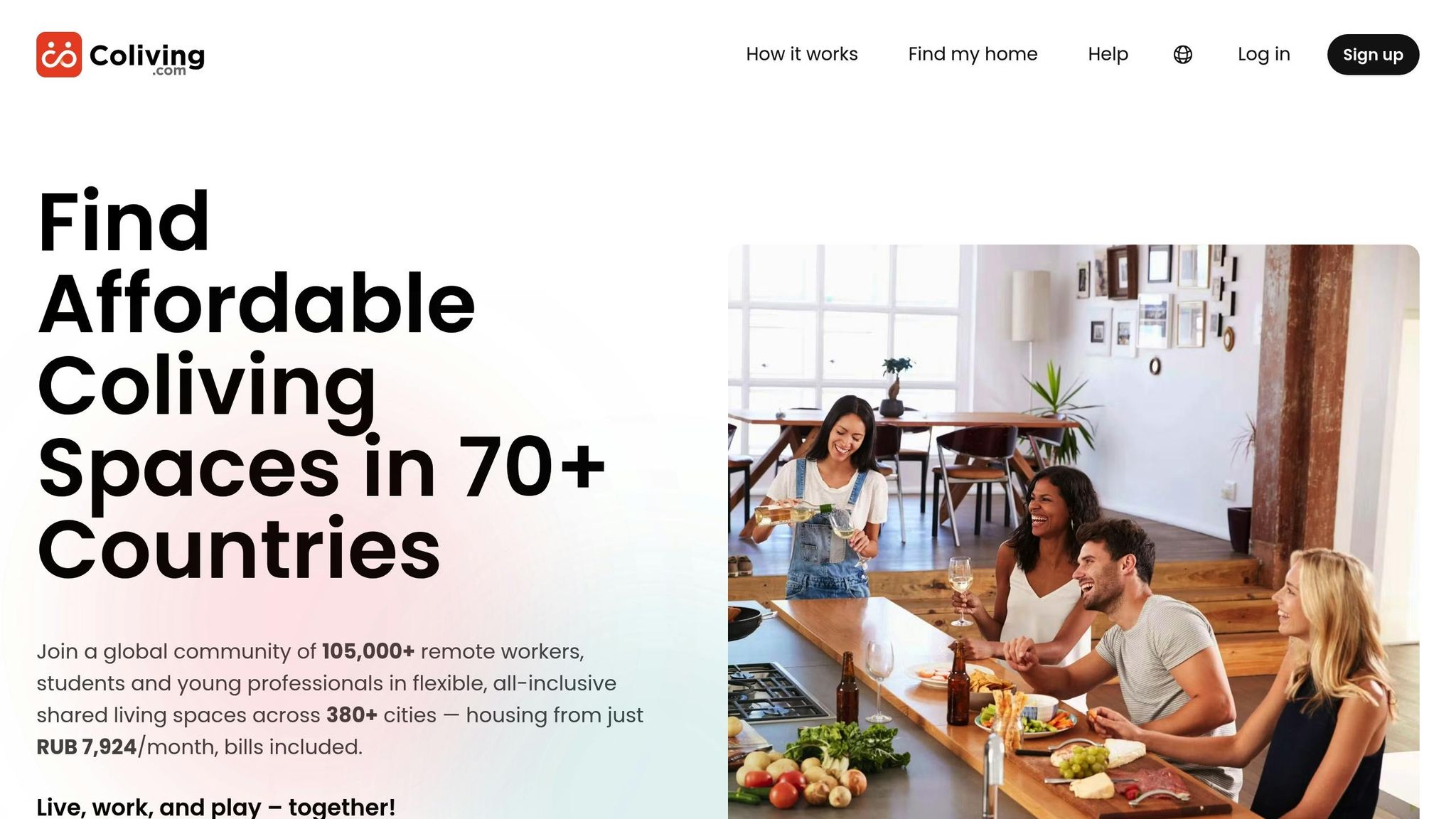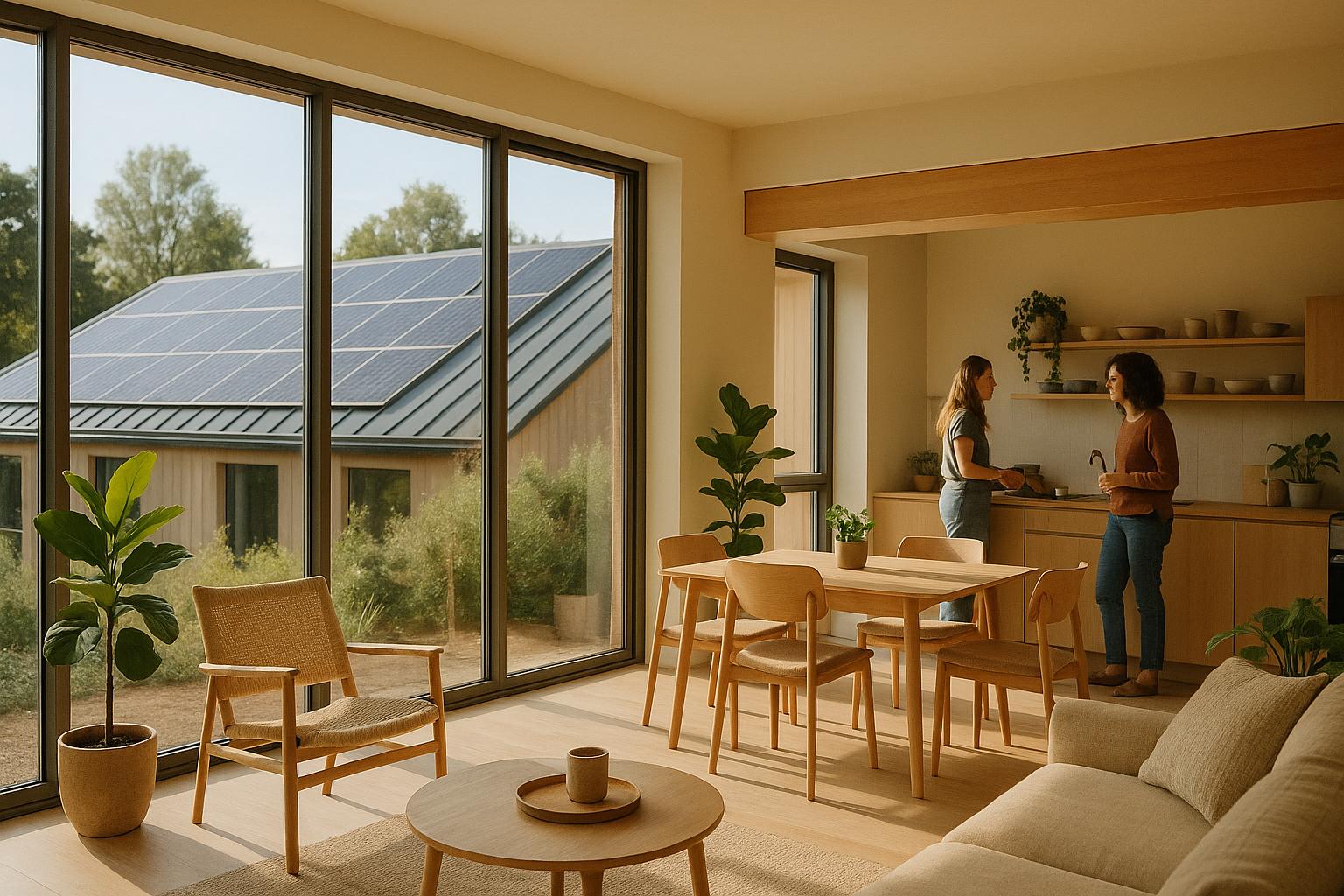Coliving in 2025 is a shared housing model combining private rooms with communal spaces, designed for affordability, flexibility, and community. Rising housing costs, remote work trends, and social isolation have made coliving a preferred option for young professionals, digital nomads, and global residents.
Key Highlights:
- Affordability: Save up to 40% compared to traditional rentals, with all-inclusive pricing (utilities, Wi-Fi, cleaning, and furniture).
- Flexibility: month-to-month leases let you move easily without long-term commitments.
- Community: 71% of coliving residents feel less lonely; shared spaces encourage connections and networking.
- Convenience: Fully furnished, move-in-ready rooms with coworking areas, gyms, and outdoor spaces.
- Global Reach: Available in 380+ cities across 70+ countries, with over 39,000 rooms worldwide.
Coliving spaces are also adapting to modern needs with smart home technology, wellness-focused designs, and eco-friendly practices. Platforms like Coliving.com simplify finding and booking spaces, making shared living accessible for today’s mobile lifestyles.
What You'll Find in Coliving Spaces
Modern coliving spaces are designed to balance personal privacy with vibrant communal living. If you're considering this lifestyle, understanding the typical setup and amenities can help you decide if it's the right fit for you.
Layout and Facilities
Coliving spaces are thoughtfully designed to combine private retreats with shared social areas. Your private room is your personal haven, often furnished with essentials like a bed, desk, storage, and sometimes even an en-suite bathroom. These rooms are ready for you to move in without any hassle.
The shared spaces are where the magic of community happens. Kitchens are fully equipped for group cooking or solo meals, and lounges with cozy seating and entertainment systems invite relaxation and connection. For those working remotely, coworking areas are a major perk, offering fast Wi-Fi, ergonomic seating, and quiet spaces for calls or focused work.
Fitness enthusiasts will appreciate the on-site amenities, which can range from basic gym setups to dedicated yoga studios. Plus, many coliving spaces feature outdoor areas like rooftops, gardens, or terraces - perfect for soaking up some sunshine, hosting gatherings, or enjoying a peaceful moment.
"Coliving is not just about providing a roof over people's heads, but about fostering vibrant communities, increasing housing accessibility, and redefining the way we think about urban living." - Artof.Co
Beyond the physical spaces, coliving simplifies life with an all-inclusive financial model.
All-Inclusive Pricing and Services
One of the standout features of coliving is its straightforward, all-in-one pricing. Instead of juggling multiple bills, residents pay a single monthly fee that covers all the essentials for comfortable living.
This approach often costs less than traditional rentals. For example, in New York City, a coliving space averages $1,799 per month, compared to $3,500 for a studio apartment. In Atlanta, coliving options can be as low as $719, while one-bedroom apartments average $1,714.
Here's a quick comparison of expenses:
| Expense Category | Traditional Rental | Coliving |
|---|---|---|
| Base Rent | Paid separately | Included in one payment |
| Utilities | Individually billed | Included |
| Internet/Wi‑Fi | Additional cost | Included |
| Streaming Services | Separate subscription | Often included |
| Cleaning Services | Extra cost | Included |
| Furniture | Upfront purchase | Fully furnished |
| Kitchen Essentials | Bought separately | Provided |
Coliving spaces also offer 24/7 professional management, handling everything from maintenance to package deliveries. Digital platforms make payments, bookings, and community interactions a breeze. And because spaces are fully furnished and stocked, you can settle in - and start living - right away.
Month-to-Month Rental Options
Traditional leases often require long-term commitments and hefty deposits, which don’t suit everyone’s lifestyle. Coliving solves this with flexible, month-to-month rental options, allowing you to adapt your living situation as needed.
This flexibility is increasingly popular, with demand for short-term rentals rising 18% year-over-year in major cities. Whether you're testing out a new city, working on a short-term project, or avoiding the constraints of a long lease, coliving gives you the freedom to move without penalties.
The process is simple and fast. Digital contracts replace lengthy negotiations, credit checks, and piles of paperwork. Many coliving spaces allow you to book and move in within days, making transitions smooth and stress-free. When it's time to leave, there's no furniture to pack, no utilities to transfer, and no waiting for deposit refunds.
This model is ideal for exploring different neighborhoods or cities without long-term commitments. You can spend a few months downtown, try suburban living, or even hop between cities - all without the financial headaches of breaking a traditional lease. Platforms like Coliving.com make the entire process seamless, from booking to move-in.
How Coliving Benefits Modern Lifestyles
As the way Americans live and work continues to evolve, coliving has stepped in as a housing solution tailored to meet the demands of today's fast-paced, flexible lifestyles. Whether you're a remote worker, digital nomad, or young professional, coliving offers a practical answer to modern challenges, blending affordability, community, and environmental awareness.
Lower Costs and Hassle-Free Living
For many professionals, high living costs are a constant concern. Coliving provides a cost-effective alternative, especially in cities where housing prices are steep. In places like Manhattan, coliving can slash housing expenses by up to 50% compared to renting a traditional studio apartment.
But it's not just about lower rent. Traditional renting often comes with hefty upfront costs - security deposits, broker fees, furniture purchases, and utility setups. Coliving spaces eliminate these hurdles by offering fully furnished accommodations with all the essentials, from high-speed internet to fully equipped kitchens.
"Flexible living is living on your own terms. It's about choosing where you live, for how long, and how you want, without the constraints of traditional leases or homeownership." - Alex Chatzieleftheriou, CEO of Blueground
With a simplified pricing model, coliving makes budgeting easier by bundling expenses like utilities and maintenance into one predictable payment. No surprises, no hidden fees - just straightforward living.
Creating Community and Building Networks
One of the biggest challenges for remote workers or newcomers in a city is the feeling of isolation. Coliving addresses this by fostering environments that encourage connection. For instance, while 69% of people have never shared a meal with their neighbors, 76% believe shared meals help build stronger bonds. Coliving spaces are designed with communal kitchens, dining areas, and lounges to bring people together naturally.
Beyond easing loneliness, these shared spaces often lead to professional growth. Research shows that people who feel a sense of community are 58% more likely to thrive and 55% more engaged in their work. Living with individuals from diverse backgrounds can spark creativity and open up new opportunities. Many coliving communities even host events, workshops, and networking sessions to deepen these connections.
"Coliving for remote workers is more than just a housing option; it's a lifestyle choice that promotes connectivity, creativity, and flexibility." - Or Goldschmidt, CEO of Roomrs
This built-in support system makes moving to a new city or starting a new chapter feel much less daunting.
Simplified Moving and Flexibility
Traditional housing often ties people down with long leases and complicated moving logistics. But in a world where jobs and lifestyles are increasingly mobile, coliving offers the freedom to move with ease. Month-to-month agreements allow you to adapt quickly - whether you're exploring a new city or chasing a career opportunity.
Because coliving spaces come fully furnished and include utilities, there's no need to pack up furniture or deal with setting up services. Moving becomes as simple as packing a suitcase and showing up.
A Greener Way to Live
Shared living naturally lends itself to more eco-conscious habits. By pooling resources like appliances and utilities, coliving reduces overall consumption and minimizes waste. Many operators also incorporate energy-efficient systems, recycling programs, and sustainable building practices to further reduce environmental impact.
Coliving spaces are often located in central urban areas, close to public transportation and essential amenities. This reduces the need for cars, cutting down on commute times and carbon emissions. For those looking to balance affordability with a commitment to sustainability, coliving offers a thoughtful way to live lightly while still enjoying modern conveniences.
How Coliving.com Works

The growing need for flexible housing has turned Coliving.com into a go-to marketplace for connecting people with coliving spaces around the globe. Think of it as making the process of finding shared living arrangements as easy as booking a hotel room. By embracing the convenience and connection that coliving promotes, Coliving.com has streamlined the experience for today’s mobile lifestyles.
At its core, Coliving.com is a digital hub where you can browse, compare, and book coliving spaces in major cities worldwide. With over 1,900 coliving spaces and 38,000+ rooms available, the platform serves a community of 105,000+ members who have shared 16,000 reviews to guide others. This platform simplifies every step, from exploring options to securing your spot, making coliving accessible to a global audience.
Platform Features and Pricing
Coliving.com’s booking process is designed to save you from the usual headaches of apartment hunting. Forget about juggling multiple landlord negotiations or deciphering complex lease agreements. The entire process is online and can be completed no matter where you are.
Trust and safety are prioritized in every transaction. Payments are only released 24 hours after you’ve moved in, ensuring the space meets your expectations. Plus, the platform backs this with a money-back guarantee.
Pricing is straightforward and reflects the diversity of its global offerings. Coliving spaces start at $100 per month, often covering utilities, Wi-Fi, and cleaning services. For example, in U.S. cities like New York, fully furnished rooms with all amenities begin at roughly $871 per month.
Coliving.com also ensures transparency by offering detailed listings. For instance, a listing for a community in SoMa, San Francisco, might include specifics like rent ($1,050), security deposit requirements, lease options (3, 6, 12, or 18 months), and added perks like weekly professional cleaning and eco-friendly initiatives.
With a 4.9/5 average rating from 16,000+ reviews, the platform’s reliability is clear. Features like 24/7 customer support and verified reviews further enhance the user experience, helping you make informed decisions.
Finding the Right Space for You
Coliving.com doesn’t just stop at offering spaces - it tailors the search to fit your lifestyle. Whether you’re a remote worker, digital nomad, student, or young professional, the platform caters to your unique needs.
The search tools let you filter by location, community type, or specific features. For instance, you might find a tech-focused community in San Francisco or a creative hub in Brooklyn that aligns with your personal or professional goals.
- Remote workers can choose spaces with coworking areas and reliable high-speed internet for seamless productivity.
- Students can explore communities close to universities, designed with study-friendly environments and like-minded peers.
- Young professionals can find spaces that focus on networking opportunities and career growth.
Each community profile goes beyond basic amenities, highlighting activities like road trips, game nights, or hiking events. To improve your chances of securing a spot, Coliving.com suggests submitting a detailed profile when booking. Include information about your background, how long you plan to stay, and what you’re looking for in a community.
With over 80,000 monthly visitors, popular spaces fill up fast. Treating the process as joining a community rather than just renting a room can make all the difference. Being thorough and responsive during the booking process helps ensure you find a space that feels like home.
What's New in Coliving for 2025
Coliving is evolving fast, with the market expected to reach $10 billion by 2025. Operators are focusing on creating better living experiences by prioritizing sustainability, wellness, and flexible work options. These advancements are reshaping coliving to meet the demands of modern lifestyles, enhancing its core appeal: flexibility, affordability, and a sense of community. A major driver of this transformation is the technology now embedded in these spaces.
Smart Home Technology
Coliving spaces are increasingly adopting smart home technology to create environments that adapt to residents' needs. With the smart home market forecasted to hit $633 billion by 2032, coliving operators are investing heavily in tech infrastructure.
AI-driven personalization is playing a big role by simplifying daily routines and encouraging community engagement. These systems can analyze resident behavior to suggest community activities, manage energy use, and streamline everyday life. In fact, smart systems can reduce energy consumption by up to 30%, appealing to both eco-conscious residents and cost-focused operators.
Standard features in new coliving developments now include app-controlled lighting, climate systems, and security. Residents can easily adjust their living environment from their smartphones, enhancing convenience and safety.
One standout example is the Eufy Smart Lock S330, which combines a 2K HD camera, doorbell, and fingerprint recognition. This device allows residents to see live video of their doorstep, communicate with visitors, and unlock their door in just 0.3 seconds - a practical and secure solution that eliminates the hassle of managing keys.
Unified smart ecosystems are also becoming more common, offering seamless control across multiple devices. Voice and gesture-based commands make managing home settings effortless, eliminating the need to juggle different apps or gadgets.
AI tools are further transforming coliving by automating event planning and resident support. These tools personalize interactions between residents, giving community managers more time to focus on fostering meaningful relationships.
Health and Green Building Focus
Sustainability and wellness are now central to coliving design. With buildings accounting for over 40% of global energy use, green construction practices have become essential.
LEED-certified buildings are leading efforts to lower carbon emissions, and investors are increasingly evaluating projects based on their environmental and social impact, alongside profitability.
"Investors, developers and tenants are increasingly placing pressure on real estate development to meet sustainable, energy-efficient standards." - Simon Chinn, Vice President of Research & Advisory Services at the Urban Land Institute
Biophilic architecture is another key trend, incorporating natural elements like planted walls, indoor gardens, and organic materials to enhance residents' mental and physical well-being. Singapore’s biophilic projects show how urban living can harmonize with nature, replacing traditional concrete facades with living greenery.
Wellness-focused amenities are also becoming standard in coliving spaces. Features like on-site gyms, yoga studios, meditation rooms, and communal kitchens designed for healthy eating are no longer optional add-ons - they’re integral to the living experience. These features promote a healthier lifestyle, both physically and mentally.
Smart sustainability features are helping reduce environmental impact while also lowering costs for residents. These innovations are often paired with flexible workspaces, creating adaptable environments that cater to modern living and working needs.
Work Spaces and Community Events
The rise of remote work has reshaped expectations for coliving spaces. Hybrid coliving models are stepping up by combining affordable housing with well-equipped workspaces, including high-speed internet, private offices, and collaborative areas.
"Homes are increasingly designed for flexibility, catering to 'multi-hyphen' individuals who balance work, leisure, and personal activities." - John Badman, Residential Leader for Gensler's Europe region
Modern coliving workspaces feature zoned areas, offering private rooms for focused tasks alongside open spaces for collaboration. Biophilic design elements are often incorporated, creating work environments that feel more like creative studios than traditional offices.
Community programming has also evolved. Beyond casual social events, coliving spaces now host mentorship programs, lightning talks, and mixers that foster both professional and personal connections.
"Community building is also central to shared workspaces. First-rate meeting spaces allow facility users to come together and forge a sense of community, while exclusive member-only events set the stage for networking. Invaluable for up-and-coming creatives or independent freelancers looking for lucrative business opportunities." - Mindspace
AI is increasingly being used to personalize these experiences. By analyzing residents' interests and schedules, it can recommend events and connect like-minded individuals. This targeted approach ensures that community activities are meaningful and relevant.
Coliving spaces are also embracing flexible lease options and customizable rooms, allowing residents to adapt their living spaces as their needs evolve. This flexibility is perfect for professionals seeking a lifestyle that moves beyond traditional work and living arrangements.
Conclusion
Coliving addresses some of the biggest urban housing challenges of 2025. With the market expected to grow at an impressive 17% annual rate over the next ten years, shared living is transforming how we think about housing, community, and sustainability.
By choosing coliving, residents can save an average of 30% on housing expenses and cut their environmental footprint by 23%. Beyond the financial and ecological benefits, coliving also tackles a growing social issue: the isolation experienced by over one-third of U.S. adults.
"Co-living is not just affordable - it's functional, social, and sustainable." - Dr. Connor Robertson
Modern coliving spaces in 2025 go beyond shared housing. They incorporate smart home tech and biophilic design to reduce energy consumption and promote well-being. Features like AI-driven personalization and wellness-focused amenities create environments that align with today’s fast-paced, connected lifestyles.
Platforms like Coliving.com make finding these spaces easier than ever. With over 105,000 users across 390 cities in 70+ countries, it simplifies the process of discovering the right community. Virtual tours, online booking, and secure payment options ensure a hassle-free experience, making it easier for people to embrace a lifestyle rooted in flexibility and connection.
Whether you’re a digital nomad, a young professional, or simply looking for a more connected and sustainable way to live, coliving offers a refreshing alternative to traditional rental options. As cities grow and housing costs climb, coliving emerges as a practical, community-driven solution that makes urban living more accessible and fulfilling.
FAQs
How does coliving help remote workers and newcomers feel more connected and less isolated?
Coliving brings people together by creating shared living spaces that naturally encourage social interaction. These spaces often host group activities, shared meals, and events, helping residents form meaningful connections and combat loneliness.
For remote workers and those new to an area, coliving provides a welcoming environment to network, collaborate, and form friendships with others who share similar interests. It strikes a balance between community and personal space, making it easier to settle into a new city or lifestyle while still feeling connected.
What are the latest technologies making coliving spaces more convenient and eco-friendly?
Coliving spaces are integrating advanced technologies to make life more convenient while prioritizing sustainability. For example, smart home systems, such as app-controlled lighting and thermostats, let residents easily adjust their living environments to suit their preferences. Additionally, AI-powered platforms simplify community management tasks, from scheduling events to handling maintenance issues efficiently.
On the eco-conscious front, many coliving spaces now include solar panels, energy-efficient appliances, and automated systems designed to save water and electricity. Some even go a step further by implementing rainwater harvesting systems and waste reduction programs. These features not only support greener living but also create a community-focused lifestyle for those who value modern amenities and environmental responsibility.
How does coliving's all-inclusive pricing compare to traditional rental agreements in terms of cost and convenience?
Coliving simplifies housing costs by bundling rent, utilities, internet, and amenities into one easy-to-manage monthly fee. In cities where housing tends to be expensive, this setup can often lead to lower overall costs compared to traditional living arrangements.
But it’s not just about saving money. Coliving also takes the stress out of managing separate bills or splitting expenses with roommates. This hassle-free approach fits perfectly with modern, busy lifestyles, making it especially appealing to young professionals, digital nomads, and those looking for a more flexible and community-driven way to live.






